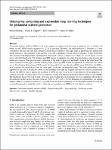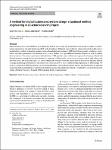Search
Author
- Jorgensen, Ed (3)
- McFadyen, Ron (3)
- Nora, El-Rashidy (3)
- Christian, Homeyer (2)
- next >
Subject
- programming (10)
- Open Access (8)
- Java (7)
- Programming (7)
- next >
Date issued
- 2020 - 2025 (293)
- 2010 - 2019 (39)
- 2000 - 2009 (2)
- 1999 - 1999 (1)
Has File(s)
- true (335)
Search Results
The problem of selecting an algorithm that appears most suitable for a specific instance of an algorithmic problem class, such as the Boolean satisfiability problem, is called instance-specific algorithm selection. Over the past decade, the problem has received considerable attention, resulting in a number of different methods for algorithm selection. Although most of these methods are based on machine learning, surprisingly little work has been done on meta learning, that is, on taking advantage of the complementarity of existing algorithm selection methods in order to combine them into a single superior algorithm selector. In this paper, we introduce the problem of meta algorithm selection, which essentially asks for the best way to combine a given set of algorithm selectors. |
Frequent itemset mining (FIM) is the crucial task in mining association rules that finds all frequent k-itemsets in the transaction dataset from which all association rules are extracted. In the big-data era, the datasets are huge and rapidly expanding, so adding new transactions as time advances results in periodic changes in correlations and frequent itemsets present in the dataset. Re-mining the updated dataset is impractical and costly. This problem is solved via incremental frequent itemset mining. |
Theoretically, domain adaptation is a well-researched problem. Further, this theory has been well-used in practice. In particular, we note the bound on target error given by Ben-David et al. (Mach Learn 79(1–2):151–175, 2010) and the well-known domain-aligning algorithm based on this work using Domain Adversarial Neural Networks (DANN) presented by Ganin and Lempitsky (in International conference on machine learning, pp 1180–1189). Recently, multiple variants of DANN have been proposed for the related problem of domain generalization, but without much discussion of the original motivating bound. In this paper, we investigate the validity of DANN in domain generalization from this perspective. We investigate conditions under which application of DANN makes sense and further consider ... |
This book is a product of a research project that tackled one of the key
challenges currently facing the software industry in Europe, and indeed
worldwide, namely, how do we transform our organization as software increasingly becomes a critical part of our business? How can we support the digitalization of assets and offerings?
This book presents the Scaling Management Framework (SMF), which is unique in
the sense that it supports the above transformation in three domains: 1) products
systems & services, 2) organization & business, and 3) methods & processes. These
domains are interdependent and are integrated into a single model in the SMF. |
Due to their unique characteristics, knowledge-intensive processes (KiPs) are difficult to capture with conventional modeling and management approaches. One such KiP is the advanced therapy medicinal product (ATMP) development process. ATMPs are highly innovative medicinal products that are based on biomedical technology. ATMP development processes need to comply with complex regulatory frameworks. Currently, biomedical scientists that develop ATMPs manage the regulatory aspects of the ATMP development processes in an ad hoc fashion, resulting in inefficiencies such as reworks or even withdrawal of ATMPs from the market. |
Qualitative spatial/temporal reasoning (QSR/QTR) plays a key role in research on human cognition, e.g., as it relates to navigation, as well as in work on robotics and artificial intelligence. Although previous work has mainly focused on various spatial and temporal calculi, more recently representation learning techniques such as embedding have been applied to reasoning and inference tasks such as query answering and knowledge base completion. These subsymbolic and learnable representations are well suited for handling noise and efficiency problems that plagued prior work. |
Utilizing fog computing and explainable deep learning techniques for gestational diabetes prediction Gestational diabetes mellitus (GDM) is one of the pregnancy complications that poses a significant risk on mothers and babies as well. GDM usually diagnosed at 22–26 of gestation. However, the early prediction is desirable as it may contribute to decrease the risk. The continuous monitoring for mother’s vital signs helps in predicting any deterioration during pregnancy. The originality of this paper is to provide comprehensive framework for pregnancy women monitoring. The proposed Data Replacement and Prediction Framework consists of three layers which are: (i) IoT Layer, (ii) Fog Layer, and (iii) Cloud Layer. |
Digital business ecosystem (DBE) is a paradigm that enables developing and monitoring novel business models of collaborating organisations and individuals using ICT as the foundation. Different from traditional online networked models such as manufacturer, retailer, or franchise centred, using a shared digital environment, DBE fosters heterogeneity, symbiosis, coevolution, and self-organisation of its multiple actors, which enables it to span different business domains as well as exhibits diverse interests. For many organisations and individuals, DBE presents a new collaborative approach to leverage offered and desired resources among the involved members to meet each of their goals. |
Classical music, unlike popular music, is usually recorded live with close microphone techniques. For this reason, isolated tracks are not available to create the final mixture/stream, and so the mixing process requires greater effort. Source separation methods are a potential solution to this problem. However, current algorithms are not fast enough to yield real-time separation in professional setups with dozens of microphones and sources. In this paper, we propose a fast approach consisting of a panning-based multichannel non-negative matrix factorization model to separate classical music. We tested the system on real professional recordings, where we were able to reach real-time with very low latency and promising quality. |
This open access book, published to mark the 15th anniversary of the International Software Quality Institute (iSQI), is intended to raise the profile of software testers and their profession. It gathers contributions by respected software testing experts in order to highlight the state of the art as well as future challenges and trends. In addition, it covers current and emerging technologies like test automation, DevOps, and artificial intelligence methodologies used for software testing, before taking a look into the future. The contributing authors answer questions like: "How is the profession of tester currently changing? What should testers be prepared for in the years to come, and what skills will the next generation need? What opportunities are available for further training... |










